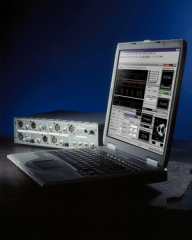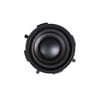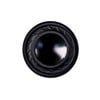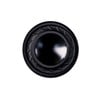Audio Analyzers Information
 Audio analyzers measure the noise and audio spectrum of output from an amplifier or a stereo.
Audio analyzers measure the noise and audio spectrum of output from an amplifier or a stereo.
Types of Audio Analyzers
There are three basic product types:
- analog
- digital
- converter-based
Analog audio analyzers use analog hardware to generate signals and analog filters to measure them. By contrast, digital audio analyzers use digital signal processing (DSP) algorithms to both generate and analyze signals in the digital domain. Today, most professional-grade audio analyzers are converter-based devices that generate and analyze signals in the digital domain and use analog-to-digital converters (ADC) and digital-to-analog converters (DAC) for analog input and output.
Features
Basic format parameters include:
- number of channels
- communications interface
- operating system (OS)
- dimensions or form factor
Audio analyzers generate sine waves, square waves, random noise, and combinations of these signals. For optimum performance, some products use multiple oscillators or waveforms in the analog domain. Typically, converter-based audio analyzers are used when analog methods are unable to generate specific waveforms. By using DACs, these devices can produce not only multi-tone waveforms and shaped burst, but also sine waves with inter-channel phase shifts—a technique that is especially useful in testing surround-sound decoders. Balancing sharpness of filtering against distortion reduction is difficult, however, and sharper filters may introduce more response ripples. Therefore, most high-performance audio analyzers have a dedicated analog oscillator for total harmonic distortion plus noise (THD+N) testing.
Specifications
Audio analyzers carry product specifications for both generator and analyzer performance. Generator performance specifications consist of sine frequency range, frequency accuracy, intermodulation distortion (IMD) test-signal type, maximum amplitude, amplitude accuracy, flatness, and digital-output sampling rate. The analog output configuration for audio analyzers is either balanced or unbalanced. Analyzer specifications include maximum rated input voltage, maximum bandwidth, amplitude accuracy, amplitude flatness, residual input noise, fast Fourier transform (FFT) resolution, IMD measurement capability, and DC voltage measurement. Mounting style and form factor are also important to consider. Audio engineers and audio technicians use audio analyzers in a variety of settings, including design laboratories, broadcast facilities and production lines.
Standards
Suppliers of audio analyzers may be accredited by the American Associations for Laboratory Accreditation (AALA) under ISO/IEC 17025:2005, a standard from the International Standards Organization (ISO) and the International Electrotechnical Commission (IEC).
Related Information
CR4 Community—Build an RF Spectrum Analyzer



